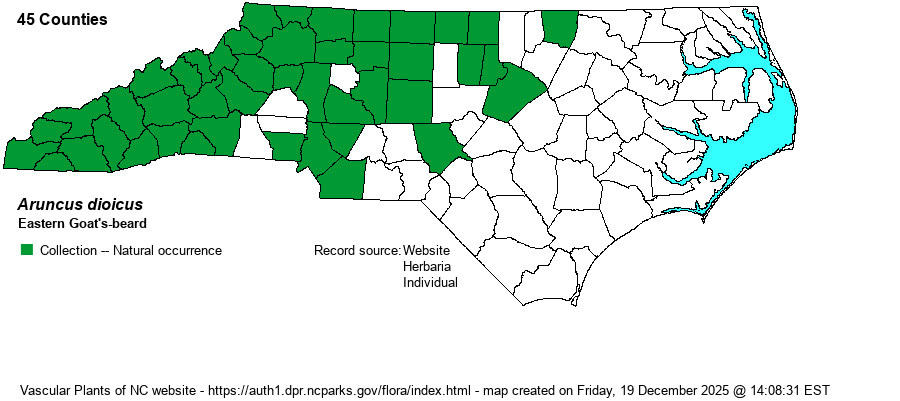| Author | (Walter) Fernald | |
| Distribution | Throughout the Mountains and Piedmont foothills, and also throughout the northwestern part of the Piedmont, east to Warren and Wake counties. Present in much of the southeastern Piedmont, but many counties there without records. Does not occur in the Coastal Plain.
This is a Mid-Atlantic and Midwestern species, ranging north only to western PA and eastern IA, and south to central AL and AR.
| |
| Abundance | Common across the Mountains; fairly common in the western and northern Piedmont, becoming rare to uncommon in the northeastern and southeastern portions of the province. Likely absent in a few areas close to the Fall Line. The website editors recommend a State Rank of S5 for this common montane species, known from nearly half of the state's counties. | |
| Habitat | This species grows mainly in rich forests, such as Rich Cove Forests in the Mountains and Basic Mesic Forests in the Piedmont. It can range into less high pH soil as long as the soils are rather moist, such as in Mesic Mixed Hardwood Forests. It does grow along margins and openings of such rich hardwood forests and can often be seen from forested mountain roads. |
| Phenology | Blooms in May and June, and fruits from June to September. | |
| Identification | This is a tall and robust herb, growing to about 4 feet tall on average. It has scattered alternate, very large compound leaves, to about 20 inches long, generally twice compound, with often 15-20 or more leaflets, each being ovate, about 4 inches long and half as wide, doubly-serrated, with an acuminate tip. These large compound leaves look remarkably like those of Astilbe biternata; however, in that species the terminal leaflet (and at times some others) is usually three lobed like a maple (Acer) leaf. Aruncus never has dissected leaflets. The very large and open panicle of (uncountable) small white flowers terminating the stem is also very similar to that of Astilbe. Note that Aruncus is dioecious, with male flowers on one plant and females on a separate plant. Another separation character is that Astilbe has flowers with 10 stamens and 2 pistils per flower, whereas these reproductive parts are on separate plants in Aruncus, which has 20 stamens in each male flower and 3-4 pistils in each female flower. Sometimes, younger leaves of Aruncus can have a bronzed look, slightly brownish-green. Both of these species are very striking when in bloom, owing to their height, numerous leaflets on large leaves, and wide-spreading flower clusters. Both can be seen from US Forest Service roads in the mountains, especially during May and June when the flower stalks should catch your attention. | |
| Taxonomic Comments | Weakley (2018) lists the nominate variety -- A. dioicus var. dioicus -- as the one occurring in NC.
| |
| Other Common Name(s) | Goat's-beard, Bride's-feathers, Buck's-beard. Most references simply use Goat's-beard, but Astilbe is universally named as False Goat's-beard, and thus a modifier name is preferred. | |
| State Rank | S4 [S5] | |
| Global Rank | G5 | |
| State Status | | |
| US Status | | |
| USACE-agcp | FACU link |
| USACE-emp | FACU link |

